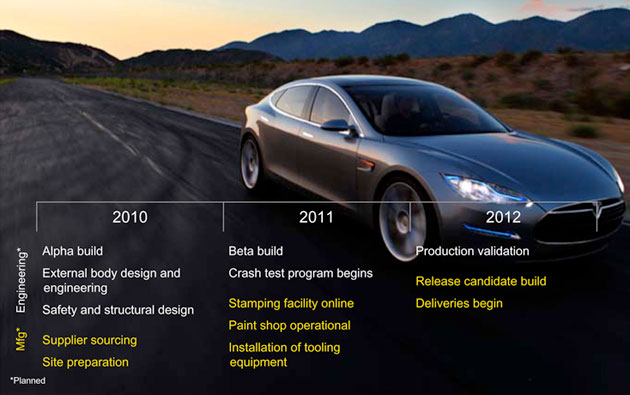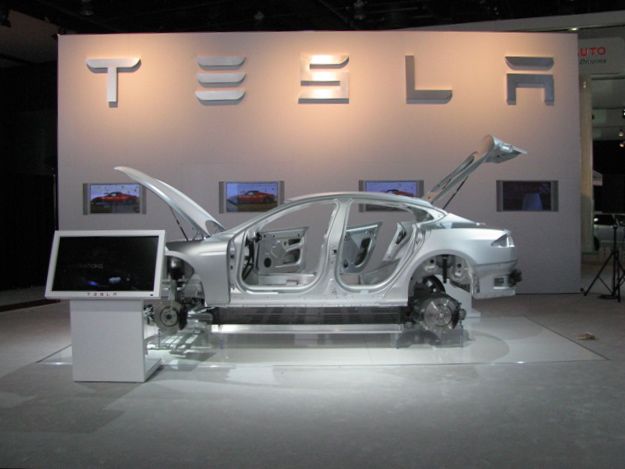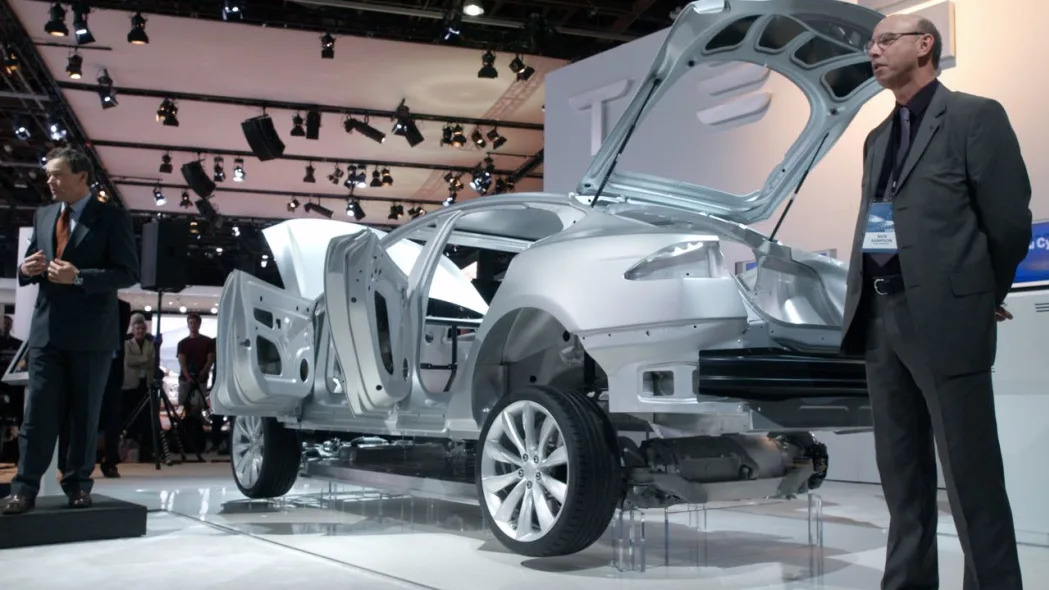Peter Rawlinson with Tesla Model S Alpha Build Prototype – Click above for the high-res image gallery
Tesla Motors is on a mission. We all know that the company's big plan is to electrify the automobile, but that's a long ways away. The company's real day-to-day work is to get ready for the Model S. During the Detroit Auto Show, we asked Peter Rawlinson, Tesla's vice president and chief engineer for vehicle engineering, what steps Tesla will take to bring the Model S to market and he admitted that there are a lot of hurdles that the company still needs to jump. These include getting the old NUMMI factory (now known as the Tesla Plant in Fremont, CA) ready to mass produce these cars and moving the Model S from the current Alpha testing through Beta testing and finally to production. Each of these steps contains a lot of little steps, but Rawlinson said that Tesla is "on track" to deliver the Model S in 2012 (possibly in the second quarter). Get the full details after the jump.
Photos copyright ©2011 Sebastian Blanco / AOL
What is Alpha testing anyway? Rawlinson said that it's a stage in the vehicle's development where things are about 80 percent finished. This doesn't mean that everything in the car is 80 percent of what it'll be in the end. Instead, some aspects might be totally locked down now, some might half-way there. The Model S' suspension, for example, is nearly production intent, as are elements of the subframe. The Alpha phase also includes a range of tests, things like brake and winter testing. "It's very important we have this window of opportunity, this winter, to get cold weather brake testing [for the Model S]," Rawlinson said. This includes making sure the antilock, stability control and electronics systems work together correctly. The first Alpha build prototype ran in December 2010 and is being used for the winter testing. "We are currently in full swing producing our Alpha prototype fleet," Rawlinson said. He declined to give a number about how big the fleet will eventually be, but we did find out that there are about a half dozen Alpha builds in existence right now. The other vehicles will be used to improve ride and handling development, powertrain integration, and some will be crash-tested in-house. "This is not for homologation purposes. It's for our own learning and also to provide data for our airbag development program," he said. "That's a huge activity, getting crash pulse information for airbags, to determine when an airbag fires." After that comes the Beta fleet, and then there will be vehicles made on the production line that will be crash tested for homologation purposes.

To accomplish these tasks, Tesla has brought in people not only from other automakers and Silicon Valley, but also from various suppliers, because "there is a lot more knowledge in the supply chain than meets the eye," Rawlinson said. The company has hired aerodynamicists from the airline and racing fields, as well. Another part of the Tesla strategy is to work with OEM partners, specifically Toyota and Daimler. For its OEM partnerships, Tesla is supplying Toyota or Daimler with either the battery (Smart ED, electric A-Class) or the whole electric powertrain system (RAV4 EV). The relationships are multi-faceted, since those companies have also invested in Tesla. As we've reported, Tesla is also learning from these companies, especially when it comes to ramping up production.
Tesla has said it will make 7,000 Model S units in the first 12 months, and 20,000 a year after that. So far, since the Roadster went on sale in early 2008, the company has only sold 1,500 Roadsters, so the Model S is quite an expansion. Rawlinson said that he is very conscious of that as he prepares the vehicle:
Rawlinson said that the engineering and manufacturing teams have a very close working relationship, which isn't all that common. "In my past experience at car companies, the relationship between engineering and manufacturing has been downright adversarial, and it's not like that at Tesla," he said. "I have a full commitment to design a car that can be manufactured and they have a commitment to not stymie that design by inappropriate manufacturing constraints."You have to design for volume, you have to design for process, and those volumes have to be volume appropriate and scalable, so it's absolutely appropriate that you design with volume in mind. The Model S is a very different animal from the Roadster so we have different processes, and different technologies that are appropriate for 20,000 units per annum.

How is Rawlinson preparing the Model S for large-scale production? He said the subtleties of some of the stampings and castings have been changed, and the way the power electronics and motor and the multilink rear suspension are "a modular unit that's going to suit a modular philosophy for assembly on the production line" is all due to getting ready for making a lot of these cars. Another consideration is that Tesla will be bringing out the Model X, an SUV planned for 2014 or so:
One thing won't change from the Roadster to the Model S, and that's Tesla's use of a single-speed transmission (remember this?). Rawlinson said, "We are committed to a single-speed, we think that's the right solution. We are putting our effort into really optimizing a beautifully engineered single-speed that is optimized for efficiency." Tesla is not testing two-speed transmissions in the Model S.Our focus is on the Model S, but we are cognizant of the value of the platform for future derivatives. We are incorporating certain features in the design, some subtleties which look a little bit beyond the Model S. For example, we have engineered the castings to accommodate the bandwidth of mass that is likely to be experienced on that platform. In other words, not just making castings that will be strong enough in an impact to support a Model S. What if there's another model in the future that is a couple hundred pounds heavier? We wouldn't want to have to put a new set of castings in because they are only strong enough for the Model S.
All of this work should result in a highly refined vehicle when the public finally gets a crack at it next year. Rawlinson said:
For $57,400, drivers will expect nothing less.I believe that quality is designed in from the very outset. As long as we do our job correctly in engineering and design a quality product, which desensitizes fit and finish conditions, accommodates tolerance in a structured manner, then that is the foundation for a quality automobile.



Sign in to post
Please sign in to leave a comment.
Continue